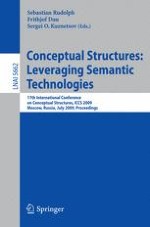2009 | Buch
Conceptual Structures: Leveraging Semantic Technologies
17th International Conference on Conceptual Structures, ICCS 2009, Moscow, Russia, July 26-31, 2009. Proceedings
herausgegeben von: Sebastian Rudolph, Frithjof Dau, Sergei O. Kuznetsov
Verlag: Springer Berlin Heidelberg
Buchreihe : Lecture Notes in Computer Science
